You're using an outdated browser. Please upgrade to a modern browser for the best experience.
Please note this is a comparison between Version 1 by Richard Blanchard and Version 2 by Vivi Li.
About 3 billion people use conventional carbon-based fuels such as wood, charcoal, and animal dung for their daily cooking needs. Cooking with biomass causes deforestation and habitat loss, emissions of greenhouse gases, and smoke pollution that affects people’s health and well-being. Hydrogen can play a role in enabling clean and safe cooking by reducing household air pollution and reducing greenhouse gas emissions.
- hydrogen cooker
- clean cooking
- decarbonization
- modelling and simulation
- techno-economic analysis
- hydrogen economy
- developing countries
1. Introduction
Cooking is an essential activity that plays an integral role in facilitating microbiological food safety [1][2][3][1,2,3] by killing active bacteria such as Salmonella and E. coli. However, cooking is an energy-intensive process on a domestic scale, and this compels about 2.8 billion people to use polluting fuels such as charcoal, wood, cow dung, and crop residues. Access to clean and affordable energy is a basic human need and is emphasized in the United Nations Sustainable Development Goal (SDG) 7 [4]. Moreover, the United Nations SDGs are highly interlinked, and clean cooking has a pivotal role in meeting them. Clean cooking can play a part in meeting SDGs 3, 5, and 13 by promoting good health and well-being, combating gender inequality, and mitigating greenhouse gases. For example, the role of a kitchen in promoting gender equality has been overlooked in developing countries—which is one of the reasons why over 300 million people in developing countries still use wood fuels for cooking [5][6][7][8][5,6,7,8]. The kitchens (which are predominantly seen as women’s responsibilities in the global south) are usually left out of the decarbonisation picture. The pollution from wood fuels affects the health of the users such as premature death through indoor pollution—which is severely experienced by women and children [9][10][9,10]. Women’s needs are usually ignored during policy formulation resulting in a lack of appreciation of these policies by women [6].
Developing countries do not only depend on traditional biomass as the primary energy source for cooking but also to meet daily energy requirements such as heating. Pachauri et al. [11] defined clean cooking as cooking with liquid petroleum gas, electricity, and piped fossil fuel gas which results in little or no household emissions. However, this implies that cooking with electricity from coal or oil is also clean cooking. Thus ‘household’ should be removed from the definition. Over 80% of the global population without access to clean cooking is located in Africa and Asia [12]. Combusting biomass fuels to satisfy household energy requirements contributes to global warming, promotes inequality, worsens energy poverty, threatens the health of people, increases indoor and outside air pollution, and reduces the life span [13][14][15][16][13,14,15,16]. Moreover, an extended recession after the COVID-19 pandemic could increase the population without access to clean cooking by 470 million in 2030, with adverse effects in Sub-Saharan Africa and Asia [11].
These challenges highlight the crucial role that hydrogen can play in enabling clean cooking for all. Hydrogen is the most abundant element in the universe, and it exists in compounds such as water (hydrogen and oxygen) and fossil fuels (hydrogen and carbon) [17]. However, the current global hydrogen production capacity is about 120 million tons [17]. About 80% of this capacity is through steam methane reforming and coal gasification without carbon capture [18]. This production capacity represents about 65% pure hydrogen, and about 33% is a mixture with other gases [17]. This hydrogen is a feedstock in the petrochemical industries and crude oil refineries, ammonia synthesis using the Haber Bosch process primarily for fertilizer production, and methanol production for various products such as plastics [17]. This carbonized hydrogen production implies that hydrogen production should be decarbonized and scaled rapidly to meet the expected growing demand across the various sectors and new sectors/markets, such as the cooking sector.
2. Cooking Mechanisms
2.1. Solid Fuel Combustion Cookers
Solid fuel combustion or traditional cookers are extensively used in developing countries for cooking and heating. The types of solid fuel combustion mechanisms can be described as open-controlled, three-stone-controlled, and enclosed cooking mechanisms [19][38]. Open-controlled cooking is used for roasting and drying food by combusting wood fuels and crop residues. Three-stone controlled cooking is used for cooking and heating by combusting wood fuels, crop residues, and cow dung. Enclosed cooking is mainly used for cooking and heating by combusting charcoal, coal, or compressed and palletized animal dung. A coal pellet cooker is under fossil fuel, but it is a solid fuel combustion cooker. The direct combustion of solid fuels is incomplete, thus emitting carbon monoxide, volatile organic compounds, polyaromatic hydrocarbons, particulate matter, sulfur dioxide, nitrous oxides, toxic metals, and elemental carbon [19][20][21][22][23][24][25][26][27][28][29][30][31][38,39,40,41,42,43,44,45,46,47,48,49,50]. The emissions of complete and incomplete solid fuel combustion are summarized in Table 14. Besides environmental risks, these products of combustion pose significant health risks such as lung cancer and acute conditions, hypertension, and premature deaths.
| Fuel | Combustion | Emissions |
|---|---|---|
| Ideal Solid (C, H, O) | Complete | CO2, H2O |
| Incomplete | CO2, H2O, CO, NOx, VOC, PM (BC/OC) | |
| Actual Solid (C, H, O, N, S, Si, Al, Ca, K, Na, P, As, Pb, Hg, …) | Complete | CO2, H2O, SO2, NO2, PM (mineral ash) Hg, As, … |
| Incomplete | CO2, H2O, SO2, NOx, CO, VOC, NH3, PM (BC/OC, mineral ash) Hg, As, … |
Advanced solid fuel cookers aimed at improving combustion were investigated in the studies [23][32][33][34][35][36][37][38][39][40][41][42][28,42,51,52,53,54,55,56,57,58,59,60]. Gutierrez, Chica, and Perez [41][59] parametrically analyzed a gasification-based cooker. Pellet combustion showed improved efficiency of 1.1% over chip combustion due to increased biochar yield and a reduction in biomass consumption, thus resulting in lower carbon monoxide and particulate matter emissions. Similarly, Scharler et al. [34][52] investigated a top-lit updraft gasifier cookstove to reduce incomplete combustion and carbon monoxide emissions. Outdoor biomass combustion is regarded as sustainable if the rate of biomass extraction equals the biomass growth rate—but the biomass extraction rate in developing countries exceeds the biomass growth rate leading to land and forest degradation and stunted industrial growth. Additionally, complete combustion/gasification is unattainable due to the low operating temperatures of solid fuel cookers. Even if complete combustion was attainable, biomass combustion still emits carbon monoxide, volatile organic compounds, polyaromatic hydrocarbons, particulate matter, sulfur dioxide, nitrous oxides, toxic metals, and elemental carbon.
2.2. Fossil Methane and Bio-Gas Cookers
A schematic of a typical methane gas cooker utilized in developing countries is shown in Figure 1. Even though natural gas (fossil fuel gas) and bio-gas cookers fall under different cooking technology classifications due to their sources, they have the same working principle and configurations. The gas is stored in cylinders for liquefied petroleum gas or in production containers for biogas. These methane gas cookers are viewed as clean cooking technologies due to higher efficiency and lower pollutant emissions when compared with solid fuel combustion cookers. Lebel et al. [43][61] approximated that methane gas cookers emit 0.8–1.3% of the gas as uncombusted methane (a potent greenhouse gas) coupled with nitrogen oxides. Improving the combustion characteristics of these cookers is thus cardinal as has been demonstrated in the studies [44][45][46][47][48][49][50][51][52][53][54][55][56][62,63,64,65,66,67,68,69,70,71,72,73,74]. However, like advanced solid fuel combustion cookers, improving the efficiency of these cookers leads to more CO2 emissions. Thus, a long-term cooking fuel solution is essential.
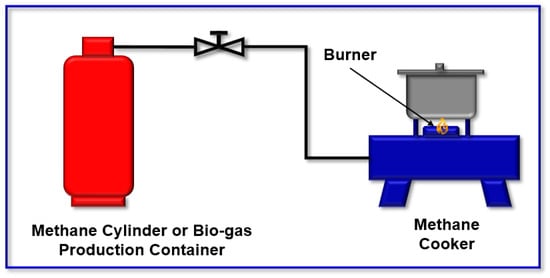
Figure 1.
Schematic of a typical methane cooker used in developing countries.
2.3. Solar Thermal Cookers
Solar cookers are either solar thermal or solar photovoltaic (PV) cookers. Solar thermal cookers convert sunlight to thermal energy, which is retained and used for cooking. Schwarzer and Silva [57][75] categorized solar thermal cookers based on the collector type and place of cooking. These are direct utilization of flat plate collectors, indirect utilization of flat plate collectors, direct utilization of parabolic reflectors, and indirect utilization of parabolic reflectors. Significant review studies on solar thermal cookers were undertaken in the recent past [58][59][60][61][62][63][64][65][66][67][68][69][70][19,21,22,23,24,27,29,30,32,76,77,78,79]. These studies reviewed geometrical designs, thermal energy storage, and nanofluids, techno-economic and social aspects of adopting solar thermal cookers. Unlike solid fuel combustion and methane cookers, the availability and concentration of sunlight limit the utilization of solar thermal cookers. However, there are efforts to improve the utilization by concentrating the sunlight and storing the thermal energy in storage mediums. For example, Abu-Hamdeh [71][80] experimentally investigated the thermal performance of phase change materials in an indirect parabolic reflector solar thermal cooker. Further advances in concentrating and thermal storage technologies are critical in making solar thermal cookers attractive by enabling cooking when there is no solar irradiation.
2.4. Solar PV Cookers
Solar PV cookers convert sunlight to electricity in photovoltaic cells, and this electricity is used for cooking by converting the electricity to thermal energy. Solar PV cookers are either electric or induction cookers. Solar electric (e) cookers use conventional alternating current (AC) converted from direct current (DC) in an inverter. However, Barton et al. [72][81] developed an innovative e-cooking system that only operates with DC. Using DC avoids using an inverter, thus preventing a 20% loss of battery energy, extra cost, and physical size of the system [72][81]. The DC e-cooking power station system is shown in Figure 2 and consists of a 25.6 V 76 Ah lithium iron phosphate battery rated at 20A (500 W), auxiliaries, and appliances. The system has a high round trip efficiency of 88%, can cook for 4 to 8 h (7.8 kg rice, 11.7 kg red kidney beans, or 9.9 L of water), has an initial cost of ($800), and can supply cooking energy for at least one meal per day [72][81].
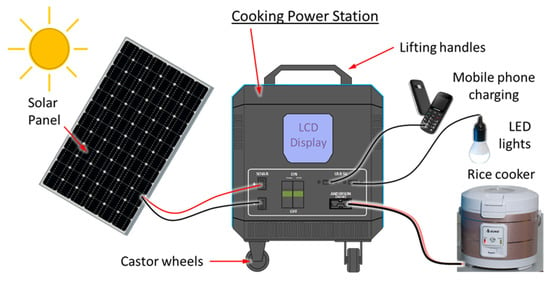
2.5. Direct Hydrogen Combustion Cooker
Hydrogen cookers are either catalytic hydrogen combustion cookers, direct hydrogen combustion cookers, or hybrid hydrogen cooking systems.
Direct hydrogen combustion is the conventional/flame combustion of hydrogen. The flame combustion temperatures range from 1200 °C to 2100 °C [74][85]. In a direct hydrogen combustion cooker, hydrogen and oxygen from the air combine through flame combustion and produce water vapour. Figure 3 shows a schematic of the proposed hydrogen cooker for developing countries. The difference with a methane cooker is the fuel source, exhaust gases, and the requirement of a flame arrestor to quench flashbacks. Flashback is the propagation of a flame towards fresh gases at high velocity in premix burners when the flow rate of the burning hydrogen-air mixture is lower than the flame velocity [75][86]. The flame may spread to where premixing is taking place (in the burner), thus leading to burner damage. The hydrogen either has to be pressurized or utilize diffusion burners for a flame arrestor to be effective and prevent this phenomenon [75][86].
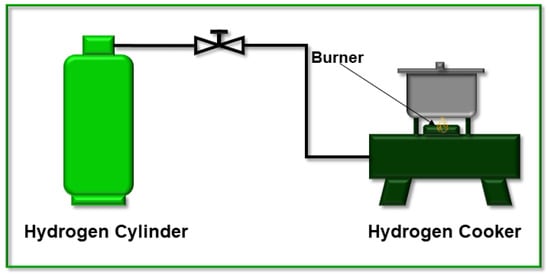
Figure 3.
Schematic of a proposed hydrogen cooker for developing countries.
A study by Vries and Levinsky [76][87] indicated that the current domestic appliance regulatory standards do not account for the flashback risk regarding laminar burning velocity. The study quantified the concept of a safety allowance to preserve the performance of the domestic burner. Even though there are experimental and numerical studies to understand and solve the flashback phenomenon [77][78][79][80][81][82][83][84][85][86][87][88,89,90,91,92,93,94,95,96,97,98], these studies are focused on large-scale and high-pressure burners, which highlights the need for studies on domestic burners. For instance, Vance, Goey, and Oijen [87][98] numerically studied the flashback limits of slit burners. They established that the traditional flashback association with the critical velocity gradient does not disintegrate the flashback data because it does not consider the stretch-induced superior diffusion effects. They, therefore, introduced a new definition of a Karlovitz number with physical insights that collapse the flashback data under all the investigated conditions. The lessons and knowledge acquired in these studies could be built on to understand domestic hydrogen burners—thus facilitating the design of stable and safe burners for residential use.
2.6. Catalytic Hydrogen Combustion Cooker
Catalytic hydrogen combustion is the complete oxidation reaction (flameless combustion) involving a heterogeneous catalyst at lower temperatures when compared with flame combustion [88][99]. Flameless combustion can be safer than direct flame combustion due to lower temperatures (room temperature to 500 °C for low-temperature catalytic combustion or 500 °C to 1200 °C for hybrid catalytic combustion), no flashback, and negligible NOx emissions [74][75][88][89][90][91][85,86,99,100,101,102]. The combustion surface of catalytic hydrogen combustion cookers also glows in proportion to the burner operating temperature, which is advantageous over the invisible flame in direct hydrogen combustion cookers [75][86]. Groβmman, Lehmann, and Menzl [92][103] proposed a non-stationary catalytic hydrogen combustion cooker with portable hybrid hydrogen storage. The purpose of the hydrogen cooker was to facilitate clean cooking for rural households without access to clean energy.
Catalytic hydrogen combustion cookers depend on catalysts and support materials [93][94][104,105]. Noble (rare) metal catalysts such as platinum and palladium are outstanding due to their catalytic hydrogen combustion activity [74][88][90][91][95][96][97][98][99][100][101][102][103][104][105][106][107][108][109][110][111][112][113][85,99,101,102,106,107,108,109,110,111,112,113,114,115,116,117,118,119,120,121,122,123,124]. However, they are expensive and characterized by poor sintering characteristics [93][94][104,105]. Catalyst support materials such as alumina and silicon carbide facilitate the effective utilization of these catalysts by improving the dissipation of activity sites and agglomeration reduction. These increase the catalytic activity and stability [97][108][108,119]. However, non-noble metal oxide catalysts with indistinguishable catalytic characteristics are potential replacements for expensive noble-metal catalysts [94][105]. These oxides are such as cobalt (II, III), manganese, nickel, and copper oxide. The results of comparative studies [114][125] showed that the non-noble metal oxide catalysts have an indistinguishable catalytic activity from rare catalysts at about 150 °C under a volumetric hydrogen concentration of 1% in the air. In a separate study, the combustion efficiency (hydrogen conversion to steam) of a cobalt-manganese-silver oxide catalyst was 99% [107][118]. However, this efficiency was under premixed hydrogen-air conditions. Perovskite-based catalysts such as La0.7Ca0.3MnO3 and 35LaCoO3/SBA-15 are also potential candidates to replace noble-metal catalysts due to their high thermal stability and catalytic activity like single-oxide catalysts [94][115][105,126]. Their characteristics enhance the catalytic activity, expanded oxygen vacancies, and defective structures (resulting in increased oxygen adsorption on their surfaces) [94][115][105,126].
Vogt et al. [109][120] developed a novel self-igniting catalytic hydrogen combustion cooker based on porous silicon carbide ceramics coated with platinum. The catalytic hydrogen combustion cooker consists of a porous silicon carbide diffuser with an open cell foam of 100 pores per inch (ppi). The diffuser overlays with a porous silicon carbide foam of 80 ppi with a porosity of ca. 87%, platinum-loaded upper foam of ca. 200 mg coated on silicon carbide 75 g [109][120]. The cooker is placed under a conventional glass-ceramic for ergonomic reasons to match electric cook stoves. Separation of the feed hydrogen at the bottom and air at the top of the porous catalytic silicon carbide leads to increased and high passive safety. The separated gases mix on the platinum-coated silicon carbide, where the hydrogen is oxidized [109][120]. Hydrogen is fed from the bottom through a brass-based pre-gas diffuser into the porous diffuser to the platinum-coated silicon carbide, where oxidation occurs [109][120]. Fumey et al. [116][127] improved the catalytic hydrogen combustion cooker previously developed in [109][120]. The cooker consists of a stack of 4 silicon carbide foams with a porosity of over 90% [116][127]. Figure 4 shows an assembled view of the cooker. A detailed description of the components is accessible from [116][127].

The maximum efficiency obtained for the catalytic hydrogen combustion cooker was 79.6% at a hydrogen flow rate of 7 Normal litres/minute and a low oxygen-to-hydrogen equivalence ratio of 1.5 due to the reduction of heat transfer in the combustion unit by reduced air flow [116][127]. They recommended a cooking temperature of more than 150 °C to maintain a low hydrogen concentration in the exhaust gas below the lower flammability limit of hydrogen (4% by volume) in air. The study indicated that condensing the exhaust steam was a limitation in improving the cooker’s efficiency [116][127]. But the exhaust steam can condense by using water in the heat exchanger as a working fluid, and unlike air, it can be stored and utilized in a household. Moreover, insulating components such as the combustion unit can also improve the overall energy efficiency of the cooker by reducing radiative losses. Furthermore, the performance of the developed cooker can be improved by optimizing various parameters such as pores per inch, catalytic surface area, and heat exchanger specifications. However, the efficiency of the developed cooker is well above the required minimum efficiency (>35%) for gas cookers with gas below glass technology according to DIN standard [116][127].
2.7. Hybrid Hydrogen Cooking Systems
Hybrid hydrogen cooking systems are proposed in this enstrudy and described as cookers primarily powered by electricity generated from hydrogen combustion, or hydrogen cookers with thermal energy (waste heat) recovery systems. The electricity for cooking is generated by small alternators that convert mechanical energy (micro gas turbines, Stirling engines, micro-Rankine cycles) to electricity. Micro combustors coupled with thermo-photovoltaics [117][128] generate electricity by converting the thermal energy (infrared wavelength light) from hydrogen combustion to electricity through the photovoltaic effect—whereas fuel cells generate electricity through the oxidation of hydrogen electrochemically.
These commercialized technologies can be implemented either on a community or household level. Barbieri, Spina, and Venturini [118][129] evaluated the feasibility of natural gas-based micro-combined heat and power systems to satisfy the domestic energy demands of single-family households. The combined heat and power technologies studied included internal combustion engines, micro gas turbines, micro-Rankine cycles, Stirling engines, and micro combustors coupled with thermo-photovoltaics. The 2011 study showed that a sensible target for the differential cost of a combined heat and power system for household heating was approximately 3000 €/kW-electric. Another work by Brandoni and Renzi [119][130] indicated that manufacturers should develop household micro combined and heat power systems with investment costs lower than 3500 €/kWe and a minimum electrical efficiency of 20%.
Bazooyar and Darabkhani [120][131] designed and optimized a biofuel micro gas turbine that fits into the 12 kW-electric Bladon recuperated micro gas turbine. The results showed that the system achieves an average electrical efficiency of 46.7%, system efficiency of 83.2%, 12 kW-electric output power, and 90% recuperator effectiveness under normal operating conditions of the micro gas turbine. The system efficiency obtained is higher than the catalytic hydrogen combustion cookers efficiency obtained by Fumey et al. [116][127] (79.6%). However, the efficiency of the catalytic hydrogen combustion cooker directly translates into heat for cooking, whereas the energy available for cooking would be 46.7% of the input energy. In addition, the catalytic hydrogen combustion cooker uses hydrogen on a household level. The micro gas turbine uses biofuel on a community level, thus making a direct comparison inadequate but sufficient to give an overview of the two systems.
Another hybrid hydrogen cooking system can be cookers powered by heat from hydrogen combustion, coupled with innovative waste heat recovery systems to generate electricity or thermal energy storage for household electrical appliances or hot water requirements. In this case, thermoelectric generators or hot water systems are more suitable for recovering the waste heat and thus can be integrated with either direct or catalytic hydrogen combustion cookers.
One of the main benefits of hybrid hydrogen cooking systems is they can reduce dependency on intermittent renewables and enable households to have electricity access at any time, unlike only during cooking time or when there is solar irradiation. Cooking occurs during specific times of the day. Thus, limiting electricity generation to cooking time may significantly reduce utilization. A parametric summary of the proposed micro combined heat and power hybrid hydrogen systems are in Table 25. Even though efficiency is a good metric for comparing technologies, what matters is the cost of a system/technology and whether it meets the various energy demands. Thus, a techno-economic comparison of these systems can inform the cost-effectiveness of these systems. Figure 5 shows a schematic of the hybrid hydrogen cooking systems. The schematic two scenarios: (i) electricity is generated from hydrogen oxidation for meeting the cooking demand and other household electricity needs, (ii) hydrogen is directly used for cooking coupled with thermal energy recovery in the form of electricity generation or hot water storage.
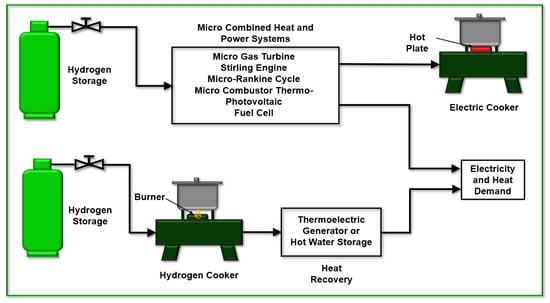
Figure 5.
Schematic of hybrid hydrogen cooking systems.
Table 25.
Micro Combined Heat and Power Systems that can be utilized in hybrid hydrogen cooking systems.
| Micro Combined Heat and Power | Electrical Power Output [kW] | Electrical Efficiency [%] | System Efficiency [%] | Moving Parts | Reference |
|---|
116][127] followed by methane at 50% efficiency [50][135][68,146]), and solid fuels at 25% efficiency [135][146].
Table 36.
Advantages and disadvantages of cooking mechanisms.
| Cooking Mechanism | Emissions | Energy Content | Usable Energy | Operating Temperature | Cooking Time | Availability | Safety | Capital and Operation Cost | |||||||
|---|---|---|---|---|---|---|---|---|---|---|---|---|---|---|---|
| Micro gas turbine | 2.7–500 | ||||||||||||||
| Solid fuel combustion cooker [19][20][21][22][23][24][28][29][30][31][38,39,40,41,42,43,47,48 | 12.3–46.7 | ,49 | >83.2 | ,50] | CO, VOC (Volatile organic compounds), PHC (polyaromatic hydrocarbons), PM, SO2, NOx, toxic metals, C, and CO2Yes | [120][121][131,132] | |||||||||
| 3.5 to 8.6 kWh/kg (wood to house coal) | 14 kWh/kg | 260 °C to 1200 °C | Normal (Conventional cooking time for any food due to controllable operating temperature) | Dependent on biomass or coal availability | Flame combustion | Charcoal cooker; Capital: $15 | [ | 72][81], Operation: $58/month | Stirling Engine | 1–50 | 13–28 | >80 | Yes | ||
| Methane combustion cooker [44][45][46][47][48][49][50][51][56][136][137][62,6352],64[,6553,66][54][55],67[,68,69,70,71,72,73,74,148,149] | [ | unburned CH4, NO | 119 | ] | [122][130,133] | ||||||||||
| x | , CO, and CO2 | 10.6 to 12.9 kWh/kg | 21.2 kWh/kg | 600 °C to 1900 °C | Normal | Dependent on methane availability | Flame combustion | LPG; Capital: $72 [138][150] to $108 [139][151] | Micro Combustor Thermo-Photovoltaic | 0.01–3 | 2–50 | >90 | |||
| Solar | Thermal cooker | No indoor emissions | 980 W/m2 [140][152], (230 to 742.9 W/m2) [141][ | No | 153] | 78.9 W (max) [140][152][117][121][128,132] | |||||||||
| 160 °C (max) | [ | 140 | ] | [ | 152], 120 °C (average) [141][153] | 40 min (6 eggs); 2 h (1.28 kg rice); 3 h 10 min (0.52 kg sheep, 0.14 kg green pea, 0.2 kg sauce) [140][152], 25 min (1 kg fries, 1 L cooking oil) [141][153] | Sunshine hours | NA | Capital: $300 to $700 [141][153] | Micro-Rankine Cycle | 1–10 | 6–19 | >90 | Yes | [118 |
| PV cooker | No indoor emissions | 1.946 kWh/17 kg battery [72][81] | 1.946 kWh [72][81], 1.8 kWh [142][83] | ][123][129,134] | |||||||||||
| - | 4 to 8 h (7.8 kg rice, 11.7 kg red kidney beans, 9.9 L water) | [ | 72 | ] | [ | 81], 52 min (0.1 kg rice, fried chicken 12 min, 17 fried potatoes) [142][83] | Dependent on energy storage capacity in a battery | NA | e-cooker; Capital; $800 [72][81], i-cooker: capital (TAC): $933 [142][83], Operation: $3.88/month [142 | Fuel Cell | Scalable (Scalable to match demand from W to hundreds of kW by stacking the cells) | >50 | >80 | No | [124][125][126][127][128][129][130][131][132][133][134][135,136,137,138,139,140,141,142,143,144,145] |
2.8. Pros and Cons of Cooking Technologies
The advantages and disadvantages of the assessed cooking mechanisms are summarized in Table 36. The proposed hybrid hydrogen cooking systems are not included in the table due to a lack of comparative data on these systems. Hydrogen as a cooking energy vector is highly attractive because it produces water when oxidized in fuel cells. However, its direct combustion for cooking at high temperatures can produce unwanted nitrous oxide, which is a potent greenhouse gas and affects human health. A way of avoiding this is by utilizing catalytic hydrogen combustors or operating at low temperatures. The catalytic hydrogen combustion cooker [91][102] showed remarkably-low nitrogen-oxide emissions of 0.09 to 9.49 ppmv equivalent to 0.007 to 0.37 mg/kWh at hydrogen flow rates of 5, 10, and 15 Normal litre/minute (0.9, 1.8, and 2.7 kW-electric respectively). The achieved figures are considerably below the current European Union regulation of 56 mg/kWh for gas ignition in heating applications [91][102]. Solid fuel cookers are the worst-performing cooking technologies in this regard followed by methane cookers. In addition to undesirable levels of nitrogen oxide emissions, solid fuel cookers emit carbon monoxide, volatile organic compounds, polyaromatic hydrocarbons, particulate matter, sulfur dioxide, toxic metals, and elemental carbon. While solar cookers do not produce emissions, they have comparatively low energy content, longer cooking time even when integrated with batteries or phase change materials, and dependability on solar irradiation. The utilizable energy (kWh/kg-fuel) is dominated by hydrogen at an end-usage efficiency of 79.6% [
| ] |
| [ | |||||||||
| 83 | |||||||||
| ] | |||||||||
| Hydrogen | DHCC [91][102] | Higher NOx emissions compared to CHCC | 33.3 kWh/kg to 39.4 kWh/kg | 42.15 kWh/kg | 1200 °C to 2100 °C | Normal | Dependent on hydrogen availability | Flame combustion | - |
| CHCC [78][95][121][89,106,132] | Negligible NOx emissions | 33.3 kWh/kg to 39.4 kWh/kg | 42.15 kWh/kg | Room temperature to 500 °C | Normal | Dependent on hydrogen availability | Flameless | - |
The operating temperature for direct hydrogen combustion (flame) can range from 1200 to 2100 °C. However, room temperature to 500 °C catalytic combustion can meet all the cooking requirements. The duration of cooking when using hydrogen, methane, or solid fuels can be adjusted by regulating the fuel flow rate. But the high energy content of hydrogen translates into lower fuel consumption per heat production. Solar cookers have higher capital and operation costs followed by methane cookers (12.5 kg cylinder, regulator, and a hose) and solid fuel cookers (which are undesirable). There are currently no studies on the capital and operation costs of hydrogen cooking systems. Thus, studies should be undertaken to comparatively model and analyze the cost aspects. However, there is a strong case for cooking with hydrogen based on the average monthly cost of using charcoal. Utilizing charcoal in developing countries is as expensive as utilizing gas in developed countries. For example, the average monthly household expenditure on methane for cooking and space heating was $56.63 (1 GBP = 1.2 USD) in 2021 [143][147]. Thus, the falling cost of renewable electricity (for hydrogen production) and the increasing cost of fossil gas (natural gas) will make domestic utilization of hydrogen attractive.
3. Hydrogen Production Pathways
Hydrogen production pathways are shown in Figure 8, where green represents hydrogen produced from renewable energy resources such as wind and solar. Pink represents hydrogen production from nuclear electricity, and brown or grey represents hydrogen production from fossil fuels without carbon capture and storage. Blue represents hydrogen production from fossil fuels (reforming) with carbon capture and storage, whereas turquoise represents hydrogen production from methane pyrolysis (cracking) with carbon capture and storage. Figure 9 shows a schematic of electrolysis in a proton exchange membrane electrolysis cell. Other pathways include thermochemical water splitting and photo-electrochemical water-splitting [144][145][146][147][148][149][150][151][152][153][154][155][156][157][158][192,193,194,195,196,197,198,199,200,201,202,203,204,205,206]. However, these pathways are currently characterized by low technology readiness levels.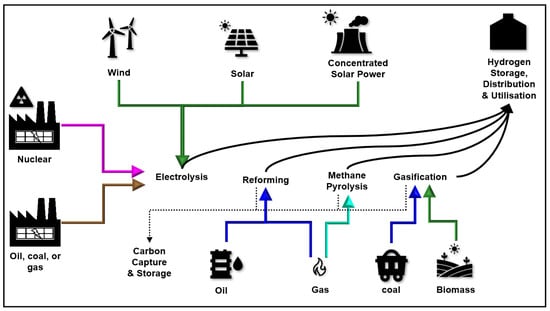
Figure 8.
Hydrogen Production Pathways.
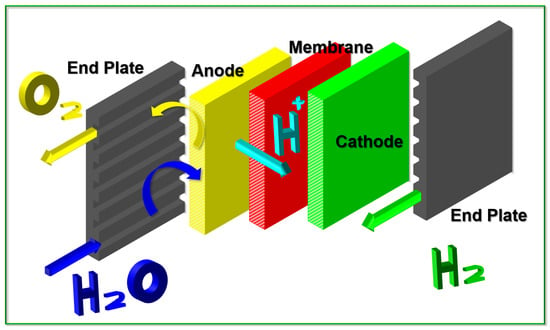
Figure 9.
Schematic of electrolysis in proton exchange membrane electrolysis cell.
